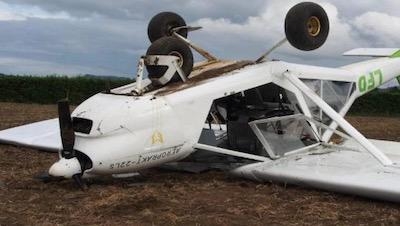Wed, Apr 03, 2019
Prolonged Exposure To UV Rays Caused The Windscreen On Rod Vaughan's Aircraft To Fail
On March 29, 2018, a pilot and passenger departed Thames Aerodrome near the Firth of Thames in New Zealand for a scenic flight to the east coast. Having been flying for approximately 40 minutes, heading back to Thames Aerodrome, the pilot flew the aircraft over the open mine to the north of the town of Waihi. While both occupants were viewing the open mine at approximately 1600 feet above mean sea level, and at a speed of 80 knots, the windscreen failed catastrophically.

The aircraft, an Aeroprakt 22-LS, was being flown by journalist Rod Vaughan. His son was also on board the airplane, according to News Hub.
The sudden inflow of air caused both cabin doors to come open and aerodynamic control became compromised. The pilot elected to make a forced landing onto open ground to the south of the town. While a successful approach was made to the chosen farm paddock, following touch down the aircraft bounced and was inverted, injuring the occupants. Emergency services attend and provided assistance.
When interviewed regarding the incident, Vaughan reported a possible collision with a drone. Examination of the aircraft and searches of the area of the mine have found no evidence of a drone.
During the examination of the aircraft it was found that there was discolouration of the plastic polymer windscreen in the form of yellowing from original clear. Subsequent laboratory examination of recovered chards and sections from the windscreen, identified evidence of Ultra Violet (UV) degradation to the upper areas of the exterior surface. UV degradation can affect the polymer bonding properties which can result in sudden failures.
Due to the high UV levels in New Zealand that can adversely degraded plastic polymers, it is recommended that aircraft are stored in a suitable building or a material cover is placed over the windows. Thorough pre-flight inspections could identify the emergence of discolouration or other defects of the aircraft transparencies. The use of cleaning materials should also be carried out in accordance with the manufacture’s requirements. Any defects noted should be discussed with a suitably qualified maintenance provider.
(Image courtesy NZ police and CAA)
More News
Aero Linx: Aviators Code Initiative (ACI) Innovative tools advancing aviation safety and offering a vision of excellence for aviators. The ACI materials are for use by aviation pra>[...]
Make Sure You NEVER Miss A New Story From Aero-News Network Do you ever feel like you never see posts from a certain person or page on Facebook or Instagram? Here’s how you c>[...]
From 2016 (YouTube Edition): Who You Gonna Call When You Have a Rocket Engine that Needs a Spacecraft? While at EAA AirVenture 2016, ANN CEO and Editor-In-Chief, Jim Campbell, sat >[...]
"In my opinion, if this isn't an excessive fine, I don't know what is... The odds are good that we're gonna be seeking review in the United States Supreme Court. So we gotta muster>[...]
Expedite Used by ATC when prompt compliance is required to avoid the development of an imminent situation. Expedite climb/descent normally indicates to a pilot that the approximate>[...]
 ANN's Daily Aero-Linx (04.30.25)
ANN's Daily Aero-Linx (04.30.25) ANN FAQ: Turn On Post Notifications
ANN FAQ: Turn On Post Notifications Classic Aero-TV: Agile Aeros Jeff Greason--Disruptive Aerospace Innovations
Classic Aero-TV: Agile Aeros Jeff Greason--Disruptive Aerospace Innovations Aero-News: Quote of the Day (04.30.25)
Aero-News: Quote of the Day (04.30.25) ANN's Daily Aero-Term (04.30.25): Expedite
ANN's Daily Aero-Term (04.30.25): Expedite



